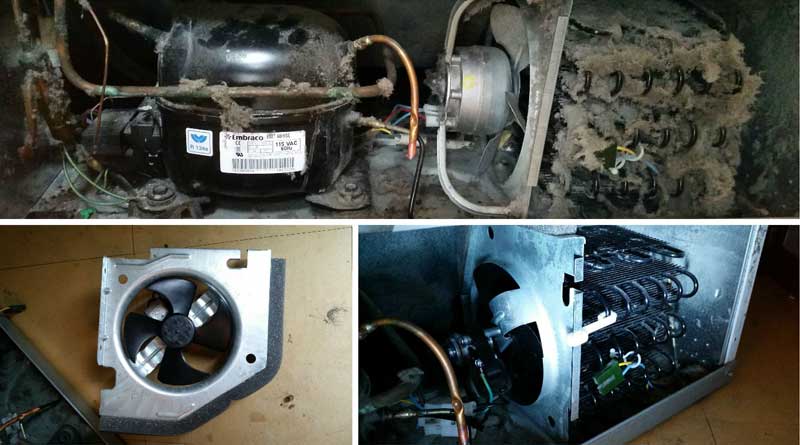Cleaning or Replacing the Condenser Fan in Refrigerators
In this article…
- Refrigerator Condenser Fan Motor – How it Works & Installation Tips
- How to Replace a Refrigerator Condenser Fan Motor
- How to Clean a Condenser Fan in a Refrigerator
- FAQ: Common Questions Asked About NF Error
Home appliances, kitchen and laundry are very popular and can be found in every house worldwide. Nowadays, we can’t imagine our daily routine without them, especially when discussing food and meal storage. It’s easy to run out of fridge space these days. Many households have two fridges (plus a chest freezer). Or you have a full-sized kitchen, a mid-sized (like a college dorm fridge) in the basement, a small chest freezer, and a beverage fridge. Obviously, a refrigerator is one of the most necessary appliances.
However, like any other appliance, the refrigerators can break down. Based upon our approximately 20 years of experience, when you face problems with them, you must be sure that the fridge technicians will return them to life as soon as possible. The professionals at FIX Appliances CA can solve most issues with all types and brands of refrigerators.
We are ready to help you with refrigerator repair wherever you live, including Toronto, Ottawa and other cities in the GTA area.
Our experts will provide same-day fridge repair services when you contact us by phone or leave a request online. You will be satisfied with a well-done job at reliable prices soon!
Refrigerator Condenser Fan Motor – How it Works & Installation Tips
A condenser fan is used on frost-free refrigerators that have a condenser coil at the bottom of the cabinet, inside the compressor compartment. The fan runs whenever the compressor runs, and it draws cool room air through the front grille and circulates it through the condenser coils, over the compressor, and back out the front grille into the room. The circulating air helps cool the condenser coils’ compressor and refrigerant. The air also helps evaporate the water in the drain pan.
If your condenser fan stops, the temperature of the refrigerant will rise, and the compressor may overheat. This will cause the temperature in the refrigerator to rise. You should check to see if there are any obstructions preventing the fan blades from turning. If the blades do not spin freely, it is likely that the motor bearings are worn out.
Condenser fan motors are usually unique to each refrigerator model. When you contact our representatives, you should tell them your appliance’s full model number and brand. This information will help us to avoid delays in finding the specific condenser fan motor you need.
How to Replace a Refrigerator Condenser Fan Motor
Below we tried to describe the following steps on how to replace a fridge condenser fan motor. Condenser fan motors are normally found near the bottom of the appliance behind a rear access panel. Follow several simple steps:
- Unplug the power cord of your appliance.
- Move the refrigerator away from the wall. Sometimes removing the base grill and raising the front levelling legs will be necessary. After that, roll the appliance forward.
- Detach a water supply line from the inlet valve before you can remove the access panel. Shut off the water supply. Unthread the screws securing the water supply line retainer to the rear panel, if applicable. Be prepared for some water to spill. Then, unthread the screws and set the panel aside.
- Reach in and push the condenser fan blade off the motor shaft. Unthread any mounting screws securing the fan motor to a mounting bracket. Disconnect the wire connector to remove the old motor fully.
- When installing a new condenser fan motor, be aware you may need to transfer rubber mounts or grommets from the old motor to the new one. Connect the wire connector, then align the motor on the bracket and thread the mounting screws. Align the fan blade on the motor shaft, then push until the blade is fully seated.
- After that, follow all these steps in reverse order. Once the repair is completed, turn the water supply back on. If applicable, plug the power cord back in, and your refrigerator should be ready for use.
Of course, there are many DIY videos over the Internet, but different models can have specific peculiarities when replacing the condenser fan motor. Thus, we’d like to advise: “If you are not sure you can do this – contact the professional refrigerator technicians”. It helps to avoid unwanted consequences if something goes wrong.
How to Clean a Condenser Fan in a Refrigerator
The other important thing you must know is how to clean a condenser fan in the refrigerator. The residents of Toronto are fond of pets. And most of them keep dogs, cats and other pets. However, pet hair gets into the refrigerator’s cooling system and clogs it. Most of our customers did not even realize they could remove the back panel and clean the dust and pet hair from the condenser fan. The condenser coils must be cleaned off every six months.
Condenser coils are responsible for removing heat from refrigerators and freezers. The large, radiator-like coils are located at the back or beneath the unit. When dust and dirt cling to the coils, it’s harder for the refrigerator to remove heat. The result is increased energy consumption. Without regular cleaning, this can lead to problems and costly repairs. Cleaning the condenser fan is easy. We use a soft brush, remove dust from the entire unit, and thoroughly vacuum the area.
While doing this, we explain how cleaning the fan a few times a year will extend the life of their compressor and refrigerator and decrease the number of times they need technicians.
FIX Appliances CA is one of the leading refrigerator repair companies in Toronto, Ottawa and the GTA areas. Our fridge experts offer high-quality repair, installation and replacement services at reasonable prices. Moreover, we provide services on a same-day basis, and you should not waste your time waiting for the fridge technicians. We will visit your place and solve the problem as soon as possible. Contact us at 888-242-0777 or submit the request online.
Date of page creation: April 27, 2022
Page update date: October 05, 2023
Ask a Question




